eISSN: 2469-2794


Review Article Volume 11 Issue 3
Nottingham Trent University United Kingdom
Correspondence: Andrew O’Hagan, Nottingham Trent University School of Science & Technology, Erasmus Darwin, Room 230, Nottingham Trent University, Clifton Lane, Nottingham, NG11 8NS, United Kingdom
Received: August 05, 2023 | Published: August 22, 2023
Citation: O’Hagan A, Hamis KM. County lines and the impact of police response: a study of Norfolk compared with East Anglia and the nation (England and wales). Forensic Res Criminol Int J. 2023;11(3):94-103. DOI: 10.15406/frcij.2023.11.00375
In the region of 88% of all police forces in England and Wales have reported the operation of lines in their area. Norfolk is one of the highest ranked areas for association with county lines. The police force and government have subsequently input a number of operations, projects, and funding to tackle the issue. This study aims to utilise national data on drug offences within the UK. It will use independent studies to create an overview of county lines activity within Norfolk and East Anglia and the impact that police response has had on the issue. Graphical representation of the drug-related arrests identifies that there is no visible difference between Norfolk and other East Anglian counties (except Hertfordshire) or the Nation (England and Wales). Furthermore, the modern slavery statistics show that the Covid-19 lockdown caused an increase in the number of referrals to social services in relation to county lines. Case studies and local statistics show that there has been an impact within Norfolk and the police and government response is reducing the number of high harm lines operating within the county. The next step for the police is to collaborate with other services to work on a holistic approach to tackling the heart of the issue. The significance of this work is to highlight county lines in individual areas and whether more could be done to tackle the problem across the UK. Further study of more local areas should be carried out for comparison and to grasp an understanding of the enormity of the situation.
Keywords: county lines, drug trafficking, exploitation, modern slavery norfolk
Rural areas are isolated from the metropolitan lifestyle. Norfolk is located in the East of England; it is ‘out on a limb’ compared to the rest of the country and on a map appears to be isolated (Figure 1, 2). Due to the outlying nature of the county, it requires a wide network of roads and public transport to give it access, not only to surrounding areas but to the whole of the country. Norwich is the only city in Norfolk and acts as the transport hub to connect the entire county together and stretches into Suffolk, Lincolnshire, and Cambridgeshire. The city has a train and bus station with routes which not only go to provincial towns within the county but also extends to London, Liverpool, and other metropolitan destinations (section 1.1.4).
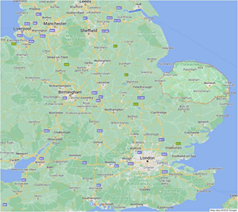
Figure 1 Map showing the location of Norfolk (outlined in red dots).1

Figure 2 Map showing the location and size of East Anglia (red).2
County lines are a criminal network which utilises transport systems, like the one in Norfolk, to transport illegal drugs. County lines are the term given to the distribution of Class-A drugs from urban to rural areas.3–5 This distribution network is managed by mobile phones known as ‘deal lines’.5 The county lines gangs exploit vulnerable children and adults, to move and store drugs and money.5 This exploitation comes in the form of human trafficking, sexual abuse, coercion and violence or the threat there of.5,6 The National Police Chief’s Council (NPCC) stated that 65% of forces have reported such exploitation.6 County lines started with the desire for localised drug trade to expand their market out of the large cities. The drug trade is moving from a traditional local retail model to a newer out-reach model.7 This is the movement of sales from urban areas to coastal and rural locations.7 There is a lack of investigation into the effect county lines drug dealing has in a rural community. There have been some reports discussing the UK wide issue but in-depth reviews into specific places are scarce. One of few case studies focusing on a localised area is by Robinson.8 This focused on Merseyside and the impact of child criminal exploitation regarding county lines. It presents the impact that coercion and exploitation can have on young people and their livelihoods. This paper is going to focus on Norfolk and the impact that county lines has had in the county. Newspaper articles and police reports will be discussed to analyse the consequences in the community. Data sets will be extracted and assessed to determine whether the efforts of Norfolk Constabulary are tackling the issue of county lines effectively.
Background
The NPCC estimates that in 88% of all police force areas in England and Wales has county lines operated within.6 Norfolk has been identified as the most prominent county for London individuals linked to county lines.9 Norfolk Constabulary and County Council have both made tackling this trade a priority. The police implemented several operations: Gravity, Orochi, and Bokken. These each target a different area of county lines and the wider issues surrounding them.
Operation gravity
Gravity was introduced in December 2016 and aimed to disrupt and prevent county lines dealing across the county.10,11 It has led to more than 800 people being arrested and large quantities of Class A drugs, cash, knives, and mobile phones seized by police.10,11 Reports by the public of illegal drug activity and knife crime to police have increased since Gravity’s introduction.11
Operation orochi
Orochi was introduced in November 2019 and is a collaboration operation between the Norfolk County Lines Team and the subsequent team in the Metropolitan Police Service. Its aim is to identify individuals who have control over the lines from London.12 Since Orochi’s introduction, 36 county lines have been shut down and 56 individuals in control of lines have been charged.12
Operation bokken
Bokken was introduced to deal with young people (aged 14-20) in Norwich who have been identified as being connected with drug-related incidents such as violence and acquisitive crimes.13 Bokken has identified two rival gangs from the city, 3G and On the Money (OTM). These gangs have committed acts of violence against each other and incite the violence through drill music.13 One example of violence between the gangs took place in February 2021 when a teenage boy was attacked by a rival group of individuals.14 He was hospitalised after being stabbed and sustained serious injuries. The attack was linked to YouTube videos criticising the other gang.14 Four teenagers were charged and sentenced with wounding with intent to do grievous bodily harm.15
Travel network
Norfolk has a strong travel network both inter-county and out of county. Routes connect towns around the county and cross-country as far as Liverpool direct. The easiest train routes from Norwich for connections to the rest of the country are the 1 hour 31-minute (average)16 service direct to Peterborough or the 1 hour 51-minute (average)17 service direct to London Liverpool Street. Peterborough is a meeting point for many trains going north or west from East Anglia. London is a haven for train transport and an individual can get anywhere in the country through the links in London.
Figure 3 shows the links between the different force areas. It can be seen in Norfolk that there are links with Merseyside and London. This suggests that individuals are utilising the direct London and Liverpool network to transport themselves, drugs, and money to Norfolk as part of a county line.
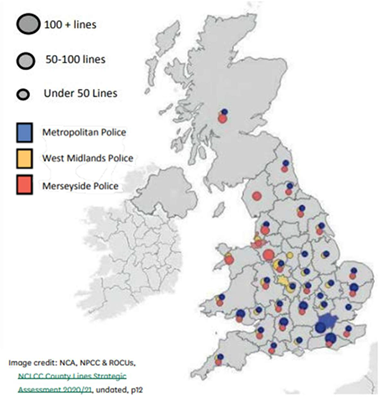
Figure 3 Map of the UK showing the number of county lines in each area and the links to the main county lines origin police forces.18
Figure 4 shows the rail network stretching from Norfolk into the other East Anglian counties. The London line, for example, stops through Suffolk in Ipswich and Essex in Colchester. There are alternative London routes through Cambridgeshire changing at Cambridge. Kings Lynn (west), Great Yarmouth (east), Cromer (north) and Thetford (south) are at each of the four compass points in the county. The routes to them are shown in Figure 4 highlighted in pink, purple and blue. Each town can be reached within an hour.
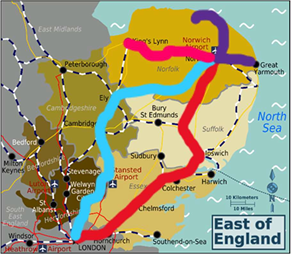
Figure 4 Map showing the train routes within and out of Norfolk.19
Commodities
Figure 5 shows the percentage of each type of drug trafficked through county lines.20 89% of all the drugs trafficked are Class A with heroin and crack cocaine being the most common. Despite heroin being the current largest percentage, crack cocaine is increasing and lines are being set up specifically for trafficking the drug. Crack cocaine is being seen as more attractive to the younger demographic than heroin which is expanding the business model and bringing in more new customers.20 The “other” section of Figure 5 contains cannabis and other lower- class drugs. Synthetic drugs and novel psychoactive substances are being recorded at the lowest quantity.20

Figure 5 Pie chart showing the percentages of each type of drug being trafficked through county lines.20
Research design
Quantitative data from various sources was considered in this study. The data creates an image of the drug activity reported in Norfolk. This data alongside news articles and police reports will be analysed to address the following:
There is no data specifically collating county lines activity. The method therefore uses drug offence data collected from police force areas in the UK. There is also minimal data on drug activities in the UK. Within this report, the data that was available has been analysed alongside statistics from reports and articles.
Data collection
This method draws upon data from the Office for National Statistics, the Census and a report from City Hall, London. These data sets are all in the public domain.
Other sources
Newspaper articles will be used from local papers. This provides case studies to support the statistics shown.
The articles will also support ideas and the research questions posed in this report.
Analysis
Data will be graphically presented, and the trends commented on. Comparisons will be made between the different geographical areas. Supporting evidence from news articles will be used to demonstrate the impact of county lines in East Anglia and the implementation of the operations in Norfolk. Utilising population estimates from the census, the locations can be compared based on a percentage and therefore can be analysed alongside each other. This will be used to answer the posed research questions in section 2.1.
Ethical considerations
Newspaper reports can be subject to media exaggeration. Mindful extraction of relevant information, statistics and points will be undertaken to ensure that there is no bias or language used which can imply an over amplification. The Census is taken every decade. It is a questionnaire each household must complete including questions on address, occupation, and ethnicity.26 The census is an estimate of the population. There are several uncertainties, such as individuals not completing the questionnaire or unregistered immigrants or refugees, therefore the population cannot be determined with an absolute precision.26 Despite this, the census can be deemed the benchmark of the population and in the Census Act 1920, is it compulsory for all individuals in England and Wales to participate. This portrays a measure of reliability at the time of the census.
Recorded drug offences
Figure 6-1221 are representative of the recorded drug offences between July 2014 and June 2022 from all six counties in East Anglia, as well as England and Wales. Although these are non-specific to county lines it gives an overview of how many individuals are getting arrested for drug related offences.
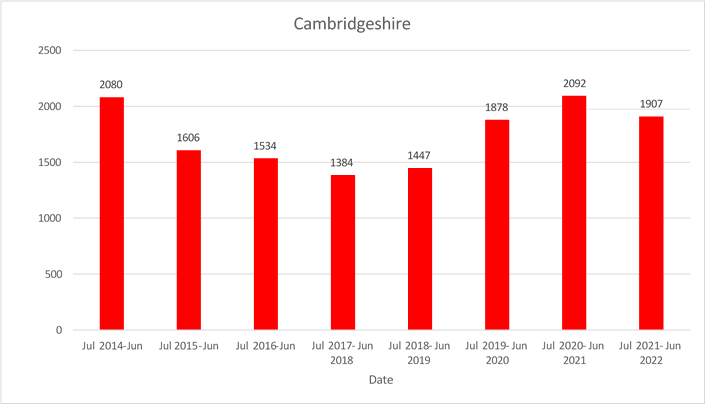
Figure 9 Graph representing number of police recorded drug offences in Cambridgeshire July 2014-June 2022.
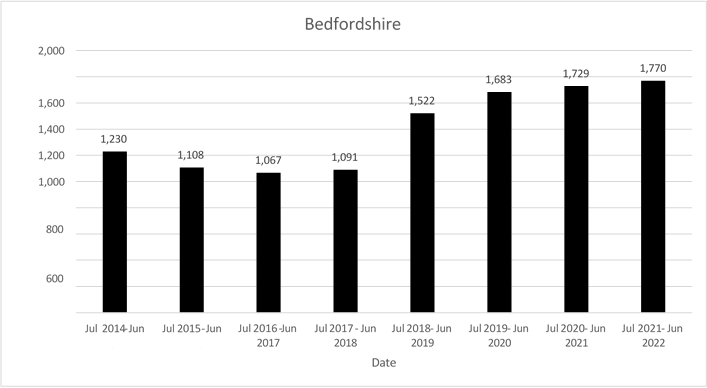
Figure 10 Graph representing number of police recorded drug offences in Bedfordshire July 2014-June 2022.
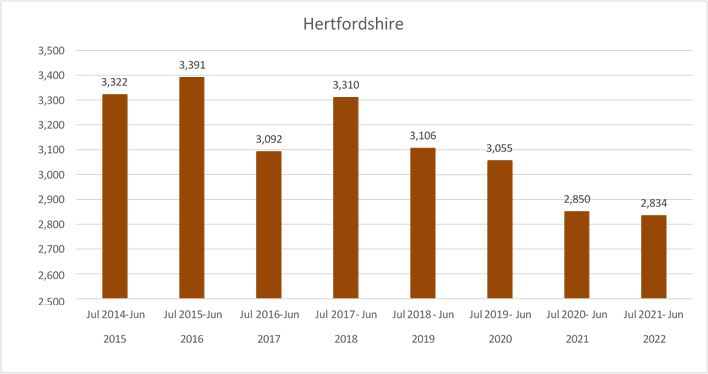
Figure 11 Graph representing number of police recorded drug offences in Hertfordshire July 2014-June 2022.
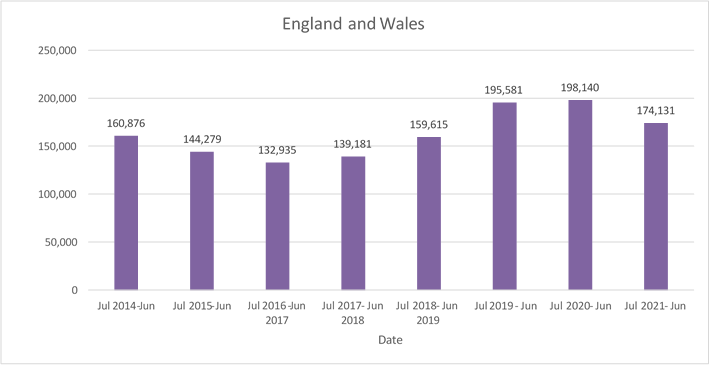
Figure 12 Graph representing number of police recorded drug offences in England and Wales July 2014-June 2022.
A comparison of all the counties and the country is represented in Figure 13.21,23,24 Taken as a percentage of the population in that area, the locations can be compared and any outlying differences can be identified.

Figure 13 Graph representing the overall trends in Figures 1-7 utilising percentages calculated with Census population data.
Norfolk, Suffolk, Essex, Cambridgeshire, and Bedfordshire have a similar trend to each other and to England and Wales. They show a wave, decreasing to 2016/17 before increasing again towards 2020/21. Hertfordshire has a distinctly different trend. There has been a major decrease in offences since 2018, contrary to the other counties which have had a decrease. This could be due to several factors. In May 2019, Hertfordshire Constabulary introduced Operation Mantis to work in partnership with nationwide county lines operations. Since the introduction of Mantis, 211 arrests have been made and several gangs have been broken down.27 In 2021/22, Hertfordshire was awarded £509,000 to help tackle drug-related crime, educate young people and support those with addictions.27 Tackling the supply, demand and misuse of drugs and alcohol has been made a priority in the Police and Crime Commissioner of Hertfordshire’s plan, specifically in a “Prevention First” approach.28 Combining these different approaches has contributed to the decrease in drug activity in Hertfordshire. All areas (except Hertfordshire, as discussed above) saw an increase in drug offences between July 2019- June 2020. The Essex increase is much higher than the rest and exceeds the trend of England and Wales (yellow). In the Summary of Drug Crime for England and Wales by the House of Commons Library,29 Essex had the largest increase in drug offences between 2010/11 to 2020/21. Essex, Bedfordshire, Norfolk, and Suffolk are four of eight police forces who saw an overall increase over this time period.29 On 23rd March 2020, the UK government imposed a nationwide lockdown advising the public to stay at home and restricting when they could leave.30 Theoretically, the restriction on the movement and interaction should have had an impact on crime rates. For the most part this was the case. The noticeable exceptions were drug offences and domestic violence.31 Figure 14 was produced as part of a statistical bulletin by Dixon and Farrell.32 This shows the percentage change of recorded drug crime across the three national lockdowns (first: Late March-June 2020, second: November 2020 and third: Late December- February 2021). The trend shows a clear increase during the lockdown periods.

Figure 14 Trend of drug crime across the Covid-19 lockdown periods in 2020/21.32
A study by Brewster et al31 outlines the impact that Covid-19 had on the county lines model and how adaptations had to be made during the lockdown periods. There had been some overall indication that the pandemic had been an inhibitor of crime31 but due to the lack of evidence and studies prior to Covid- 19, the impact can only be assessed through media representation and the opinions of experts in the field.31,33 As part of this media representation, an article by Grierson and Walker34 stated that the British Transport Police had not seen a reduction in county lines activity despite a reduction of 94% in train travel. This was due to the visibility of the young people travelling. They could no longer blend into the background of other commuters, with the lack of travellers made them easy to spot.31,34 This is echoed by Langton et al,35 who highlighted that drug offences had increased over the lockdown period contrary to prediction (Figure 15).35 This is simply due to visibility and the fall in other crimes. Therefore, the police had more resources to focus on other areas. Langton et al calls this “a salient example of proactive policing”, simply moving resources to focus on other crime opportunities.35

Figure 15 Trend of drug crime across the first lockdown (April-June 2020) (orange) compared to predicted trend (dotted line).35
The National Crime Agency (NCA) commented that the lockdown had contributed to a rise in county lines offending.18,36 Several factors were identified in driving up the rise:18
The suggestion of visibility by Grierson and Walker and Brewster et al31,34 pushed the dealing into private vehicles and in areas where traffic is higher such as supermarket car parks.18 This made the dealing harder to spot. Despite the lack of normal foot traffic in towns and cities, supermarkets maintained a high footfall as they were one of the few places open for necessities during the lockdown. This allowed for dealers to utilise vehicles which would blend into that environment instead of using public transport.
Figure 6 has a very similar trend to all others indicating that comparatively Norfolk does not have a standout number of offences when viewed against other counties in the area and the country. On a localised level, there has been an impact on the number of arrests and line closures in relation to operations Gravity, Orochi, and Bokken (sections 1.1.1, 2, 3), but there has not been a reduction in the crime rate. This is a contrast to what can be seen in Figure 11 for Hertfordshire. The clamp down and increase in funding had seen a decrease in arrests. This decrease in Hertfordshire had been due to the funding being primarily used to educate young people and help addicts.27 Sutherland6 described the importance of C.S Lewis’ First and Second Things “Put first things first and we get second things thrown in: put second things first and we lose both first and second things”.37,38 This represents the key issue with the current police response. There is a focus on intervention instead of prevention. Prevention is key in the fight against drug crime and specifically county lines and exploitation. Sutherland utilises a fictional case of a stabbing by a young male involved in drug crime and describes that the most important and first things are tackling the issues which drove this young man to crime. There should be a focus on keeping young people in education by providing them with the support they require for issues such as history of abuse within a family.6 Sutherland quotes Marmot39 about finding the “cause of the causes” which is said in relation to health but can also be applied to crime. The model that Hertfordshire has provided is an example of placing first things first and attempting to deal with the cause by educating young people. The next step for any county would be for police to utilise a holistic approach40 by collaborating with education, social services, healthcare, and various other services to go deeper into the cause of young people involving themselves in crime and breaking the cycle. This idea of placing an emphasis on the prevention techniques is reiterated in a report by Dodsworth and Sorensen.41 This report explores the issue of county lines in Norfolk and the way in which exploitation occurs. Dodsworth and Sorensen41 describe the process of grooming and how children and vulnerable adults are offered money, a relationship, or drugs to participate in the criminal activity often for this offer to be later revoked and no reward given.41 The adverse childhood experiences (ACEs) an individual may receive have an impact on how easily they can be groomed. These ACEs are listed as emotional, physical, or sexual abuse, neglect, poverty, broken home, domestic violence, parental substance misuse, parental mental health issues and parental history of criminology.41 If a child is subject to more than six ACEs they are at an increased risk of having long-term impacts later in life.41
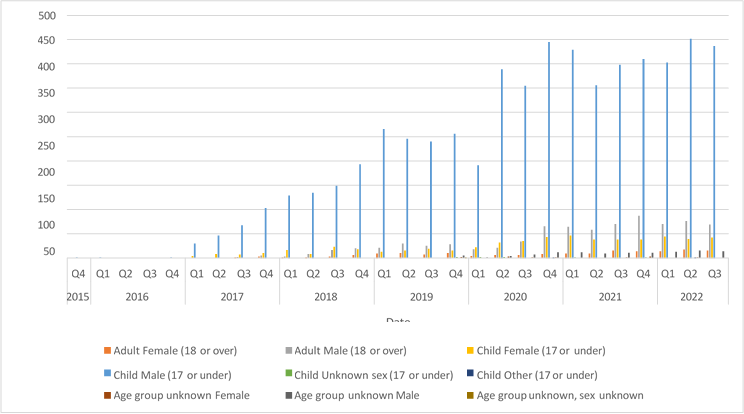
Figure 16 Graph representing modern slavery referrals made through the National Referral Mechanism flagged as county lines from 2015 to 2022.
The Home Office suggests that there are five risk factors:41
Not only are these the risk factors in which an individual may become involved in county lines but they are also the protective factors. These factors require addressing and funding to reduce the number of young or vulnerable people involved in county lines by placing these factors first as opposed to a reaction response which the police are currently using. This requires governmental input and collaboration in communities with various services to provide the support in all five areas and reduce the number of ACEs an individual has. Norfolk Constabulary has inputted the operations mentioned in sections 1.1.1, 2, 3 which are largely focused on disrupting and preventing county lines. These operations have been reported as successful with Gravity leading to over 800 individuals being arrested since December 2016.10 Orochi has shut down 36 county lines and 56 high ranking individuals controlling the lines charged since November 2019.12 Bokken is ongoing and is utilised as a monitoring operation identifying young people involved. In partnership with these operations Norfolk Police implemented the Norfolk County Lines Team which has shut down 74 lines since its establishment.42
Furthermore, Norfolk Police introduced the Safer Schools Partnership in which schools and the police work together to keep young people safe, educate them on the risk of crime and improve behaviour at school.43 The basis of the partnership’s ethos is to provide early intervention, prevention, and support to young people. This partnership places both PCs (police constable) and PCSOs (police community support officer) into schools across the county. The schools are split into two tiers, with tier one being identified as benefitting most from a full-time partnership.44 The tier one schools have 8 PCs and 2 PCSOs working across 9 schools and tier two schools have 21 PCSOs working in 42 schools.44 These officers are working at the heart of the schools and with the most vulnerable young people. A further programme implemented in Norwich called Project ADDER was introduced by the Department of Health and Social Care in 2021 to run until 2023. The project had four aims related to drug offending, deaths, and drug use.45 ADDER was launched in some of the hardest hit areas from drug crime across the UK. Norwich was identified as one of these areas. The operations Gravity, Orochi and Bokken are all reaction-based responses whereas the Safer Schools Partnership and Project ADDER are both examples of how Norfolk Constabulary are putting education and prevention first. All these factors working in collaboration will have a long-term effect on the drug crime and county lines levels in Norfolk. It can be seen in Figure 6 that despite Covid-19, since 2019 there has been a steady decrease in drug related arrests, despite Covid-19. From values published by Norfolk Constabulary10,42 the projects and operations in place are having a positive effect in the county.
Modern slavery
Section 45 of the Modern Slavery Act 2015 gives relevance to county lines. The statutory defence for victims of slavery and exploitation who:46
Figure 1625 is a graph showing the trend of modern slavery referrals made through the national referral mechanism (NRM) from 2015, when county lines was first identified by the National Crime Agency as a ‘criminal business model,’3 to 2022. The trend in Figure 16 shows an overall majority of referrals being in the ‘child male’ category. The number of referrals across 2019 remained similar before dipping at the beginning of 2020 (start of Covid-19). From Quarter 1 (Q1) 2020 to Quarter 2 (Q2) 2020, the number of referrals almost doubled. The NCA recorded that the percentage of referrals flagged as county lines in 2020 was at 14.5%, up from 11% in 2019.36 The impact of Covid-19 on the exploitation of young people was assessed in a study by Pitts. The lockdown affected access to school for many children and young people as schools were closed to all but the most vulnerable individuals and to those whose parents were key workers. Despite access to education, the most vulnerable children were not going to school due to the fear of catching Covid-19 and parents feeling the stigma of being labelled as vulnerable.47 There were as few as 5% of vulnerable children accessing the available places.48 Schools are one of the main places in which referrals are made to children’s services. With the closure of schools and the most vulnerable not accessing the available places, they were lacking the contact with professional individuals who could raise concerns to the relevant agencies and protect the young people.48 Q1 represents this lack of access to school that young people had during the first and longest lockdown period. The trend was able to recover and exceed the level seen in Q1 2020 in Q2 due to the reintroduction of young people into schools and the movement of police resources to focus on visible crime. All school staff are trained to recognise safeguarding issues with the young people in their care. The Department for Education’s keeping children safe in education guidance states:49
These updates and training give staff the skills and knowledge required to ensure that they can spot the signs of abuse, exploitation, and neglect. Staff members are further trained so they know the referral route through social services to find the best solution for the young person/people.49 Furthermore, police officers who believe that there is a safeguarding issue with the young people or vulnerable individuals they arrest or come into contact with can implement a multi-agency response.50 Figure 17 shows the response process for modern slavery referrals through first responders (police officers, school staff, social services). Modern slavery referrals can be a complex process. They should be investigated quickly and considering the safety of the victim and the type of exploitation. Many investigations include a cross over between different offences.50 County lines can be a modern slavery investigation but also a drug offences and/or a money laundering investigation. Modern slavery is categorised as an either-way offence and can incur a minimum of 12 months and/or unlimited fine and a maximum of 10 years imprisonment unless the offence involves false imprisonment or kidnapping where the sentence is life imprisonment.51
In February 2023, three men were sentenced to a total of 8 years 11 months imprisonment for modern slavery offences relating to county lines. This was after two male teenagers who had been reported missing were found in a property in Norwich with a large quantity of drugs. The boys had been trafficked from London to Norwich in order to deal drugs.52 This is an example of the power that the Modern Slavery Act 2015 can have to protect young people and vulnerable adults against exploitation.
Rescue and response studies
Figure 18–20 show maps from the Rescue and Response reports 2019 and 2020.9,22 The Rescue and Response project was set up to provide support for individuals aged 25 and under who have been impacted by county lines.9 The aim of the project is to formulate a programme which can be used to understand, target, and respond to county lines. In 2019 (year 1), 568 young people were referred to the project, 70% of which being aged 15-18 and 83% male.9 In 2020 (year 2), 553 young people were referred, 63% aged 15-17 and 82% male.22 As seen in Figure 19, Norfolk was recognized as the area with the highest number of county lines links amongst the individuals in 2019. As a result of the high number of lines associated with the county, Norfolk Constabulary set up a specific County Lines team. Since its establishment, the team has shut down 74 lines.42 The team is made up of seven police officers. Intelligence to track line holders is collected through phone data and this can be used to identify the source of the drugs and stop the movement of them.42 In addition to the shutdown of lines, 82 individuals have been convicted in relation to county lines.42 This success has been driven by operation Orochi (section 1.1.2) which has allowed for resources to be targeted at the source of the county lines as opposed to local small time drug dealers and runners (individuals used to move drugs from one place to another).42
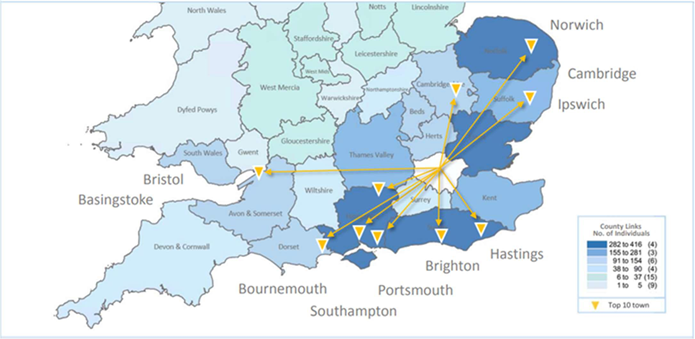
Figure 18 Figure taken from Rescue and Response report 2019 representing the top 10 towns with county lines links from London.

Figure 20 Figure taken from Rescue and Response report 2020 showing the top 10 towns with County Lines links to London.
In 2020, Norfolk dropped to sixth in the table (Figure 22). Although this is still high, it is an improvement compared to the previous year with the number of associated individuals cut by over half. Covid-19 may have had somewhat of an impact on this. The train service from London to Norwich is longer than the top three counties. The impact that visibility had on the increase in arrests could have had a decreasing effect in the number of individuals travelling that distance. The results found in 2019 also had an impact. They showed that Norfolk required a crack-down on the policing of county lines and the number of lines going into the area. This subsequently set up Orochi and the County Lines team. This focus will have continued into 2020. This can be further seen in Figure 6 as the number of arrests between 2018/19 and 2019/20 increased substantially. This highlights the increased focus which allowed Norfolk Constabulary to arrest more people for drug-related offences. In the year 2020/21, the arrests decreased again. This could be due to the impact of the implemented projects and programmes such as ADDER, Gravity, Orochi, and Bokken or due to decrease visibility of individuals after the Covid- 19 lockdown. The headline from a report by the Eastern Daily Press states “Drug lines into Norwich and Norfolk halved in 2021 after police crackdown.”40 Chief Inspector Sonia Humphreys gave an interview in which described the focus of Norfolk Constabulary on the county lines causing the highest harm. High harm lines are identified based upon factors such as child exploitation and the use or carrying of weapons.40 In November 2019, Norfolk had 75 known drug lines into the county. At time of reporting in January 2022, there were under 30 lines, fewer than 10 of these are classed as high harm.40 Humphreys also praised the project ADDER and states that Norfolk Constabulary are focusing on a holistic approach to support people who are the victims of exploitation through county lines.40 A holistic approach is not possible solely by the police, it requires input from many services to provide the best support and education to individuals.
Government response
The government launched the County Lines Programme in November 2019 with an investment of £65 million.5 Its aim was to target county lines activity across the UK by investing in technology to track vehicles, targeting the operational activity in the main exporting forces, and increasing the support for victims of exploitation.5 In 2021, the government published a 10-year drugs strategy, which included a further £145 million investment in the County Lines Programme to tackle the distribution model.5 Since the introduction of this programme in 2019, there has been the nationwide shutdown of 3588 lines, 1000 of which were closed in the past year.53 Figure 22 shows the number of lines closed, arrests and referrals to safeguarding since the County Lines Programme began. Type 1 closures are defined as the closure through the arrest and charge of a line holder. Type 2 closures are through the deactivation of a phone line. From the data in Figure 22,54 it can be seen that the number of type 1 line closures each year is increasing. On the contrary, the number of type 2 line closures increased in 2021/22 but decreased again in 2022/23, the same with arrests. The statistics show that the money the government is plugging into the programme is producing the desired results and on track to meet the target set to close 2000 lines by March 2025.5
County lines have affected the counties of East Anglia and specifically Norfolk for a substantial time. There has been every effort made by the police forces to make a difference and reduce the exploitation of vulnerable individuals and young people. The operations and projects implemented targeting county lines have produced positive results and require persistence in order for progress to be seen further into the future. Norfolk has shown a trend in drug related arrests similar to that seen nationally and, in the counties, surrounding. The proximity to London and the direct travel routes to other parts of the country have contributed to this, alongside a response-based approach to reducing the number of county lines across the county and region. Operations Gravity and Orochi are both proactively reducing the number of active lines in Norfolk and identifying individuals who have broken the Modern Slavery Act 2015 for the exploitation of children and vulnerable adults or the Misuse of Drugs Act 1971. Bokken is working behind the scenes monitoring the movements and interactions between young people known to be involved in gang and drug activity, ready to interact when deemed necessary. These operations are vital in continuing the success demonstrated in 2021 where the number of active lines was cut by half.40 To further dismantle and eradicate county lines from Norfolk, a holistic approach40 is required to focus on the heart of the issue.
This includes the collaboration between Norfolk and the key cities of Liverpool (Merseyside Police) and London (Metropolitan Police) alongside social, education, and health services to tackle societal issues associated with criminal activity6 and exploitation.41 Young people require education and support more than they have before; the loss of a year for Covid-19 opened the door to exploitation and a potential life of crime. The visibility of young people has come to light and the training for police officers and school staff has become pivotal in tackling exploitation. Project ADDER has provided funding to the worst hit areas by county lines (including Norwich) allowing Norfolk Constabulary to introduce support networks putting education and prevention first.45 The success of all these projects and operations requires monitoring and further research published on the future trends of county lines in Norfolk and East Anglia. The Response and Research project only lasted two years. Further exploration of this data and the trends in 2021 onwards would be an area of improvement to see whether Norfolk and Norwich became further down the list through time (Figures 20 and 22). This would demonstrate the impact the constabulary is having in the county and whether the plan for a holistic approach is working. The British Government has taken some steps in reducing the number of county lines across the UK. They introduced the County Lines programme in 2019 and since then there has been a reduction of 3588 lines nationwide, 1000 of which was closed in 2022 alone.53 This is showing the dedication in the country to reduce this type of crime and how important it is to ensure that young people have the chance to live in a safe country without fear of exploitation.
None.
The author declares there is no conflict of interest.

©2023 O’Hagan, et al. This is an open access article distributed under the terms of the, which permits unrestricted use, distribution, and build upon your work non-commercially.